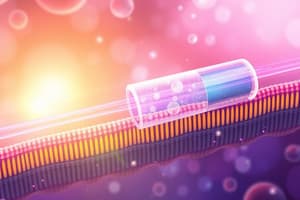Podcast
Questions and Answers
What ions does the sodium-potassium pump move into and out of the cell?
What ions does the sodium-potassium pump move into and out of the cell?
- Sodium ions in and potassium ions out
- Sodium ions only
- Potassium ions only
- Sodium ions out and potassium ions in (correct)
What is the role of ATP in the function of the sodium-potassium pump?
What is the role of ATP in the function of the sodium-potassium pump?
- To stabilize the pump's binding sites
- To create sodium concentration outside the cell
- To facilitate the diffusion of potassium ions
- To provide energy for the pump to move ions against their gradient (correct)
What happens during ATP hydrolysis in the operation of the sodium-potassium pump?
What happens during ATP hydrolysis in the operation of the sodium-potassium pump?
- Potassium ions are released into the cytoplasm
- The protein changes shape to face outside (correct)
- The pump binds more sodium ions
- The pump stops functioning
What is the effect of the sodium-potassium pump on charge distribution across the cell membrane?
What is the effect of the sodium-potassium pump on charge distribution across the cell membrane?
How many sodium ions are transported outside and potassium ions transported inside by the sodium-potassium pump during one cycle?
How many sodium ions are transported outside and potassium ions transported inside by the sodium-potassium pump during one cycle?
What is the concentration of sodium outside the cell compared to inside?
What is the concentration of sodium outside the cell compared to inside?
What characterizes the sodium-potassium pump as an active transport mechanism?
What characterizes the sodium-potassium pump as an active transport mechanism?
Which process is NOT a function of the sodium-potassium pump?
Which process is NOT a function of the sodium-potassium pump?
Flashcards are hidden until you start studying
Study Notes
Sodium-Potassium Pump
- The sodium-potassium pump is a protein that moves sodium and potassium ions across the cell membrane.
- It is an active transporter, meaning it requires energy to function, provided by the breakdown of ATP.
- Mechanism:
- The pump binds three sodium ions inside the cell.
- ATP is hydrolyzed, releasing energy that changes the shape of the protein and causes it to face outwards.
- Sodium ions are released outside.
- Two potassium ions bind to the protein on the outside.
- The protein changes shape again, facing inwards, and releases potassium ions inside the cell.
- Key characteristics:
- Moves ions against their concentration gradient: sodium is moved from a low concentration inside to a high concentration outside, while potassium moves from a high concentration outside to a low concentration inside.
- Requires ATP hydrolysis for energy.
- Creates concentration and electrical gradients across the cell membrane, which contribute to nerve impulse transmission and muscle contractions.
- Important for cell functioning:
- Maintains resting membrane potential, which is crucial for nerve impulse transmission and muscle contractions.
- ** Concentrations:**
- Inside the cell: Sodium ~10 meq/L, Potassium ~142 meq/L
- Outside the cell: Sodium ~142 meq/L, potassium ~10 meq/L
Studying That Suits You
Use AI to generate personalized quizzes and flashcards to suit your learning preferences.




